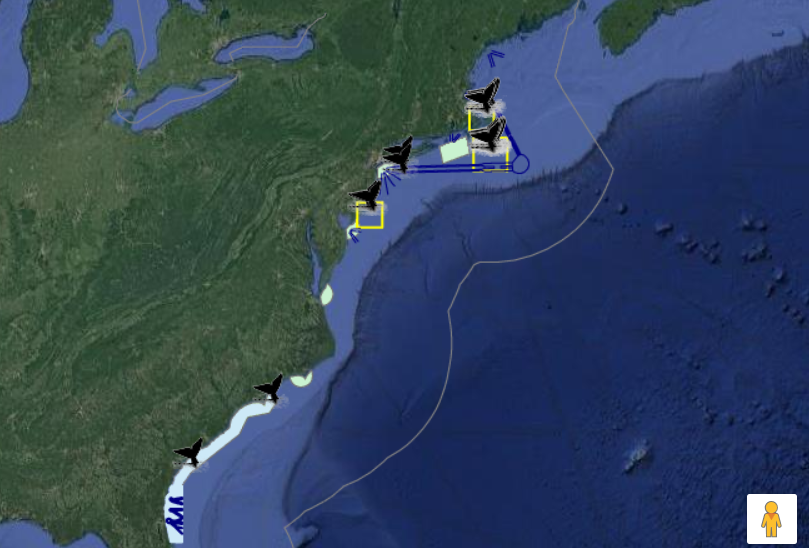

Speed Restrictions Implemented on East Coast
December 18, 2018
Update - 12/27/2018: A survey on December 24th counted 36 North Atlantic right whales south of Nantucket, representing about 10% of the entire population. The Dynamic Management Area (DMA) in Cape Cod Bay has been extended through January 2nd and the DMA south of Nantucket has been extended through January 4th but these are still just voluntary restrictions that must be made mandatory.
Update - 12/19/2018: Surveys found 33 North Atlantic right whales south of Nantucket on December 15th and 4 right whales off the coast of New Jersey on the 14th. There were also sightings of 10 in Cape Cod Bay on December 11th and 7 in Cape Cod Bay on December 19th. It's not yet known if any of the Cape Cod Bay whales from the 19th were ones from the 11th but at least 10 have been seen in the area in the past eight days. The 47 right whales in these areas represent over 10% of their entire population. The fact that the speed limits in all of these areas are still voluntary, even with this many whales being sighted, is completely unacceptable. The mandatory speed limits in the Southeast US that we mention in the post below currently cover an area where two female North Atlantic right whales were seen on December 12th and another sighting of two right whales (not sure if they're the same two) occurred on December 17th. It's great that they have some protection but this means that at least two, possibly four, North Atlantic right whales have better protections than the 47 right whales off the coast of Massachusetts and New Jersey. The speed limits must be expanded and made mandatory if these whales are to be truly protected.

A map of recent sightings of North Atlantic right whales (12/3-12/17) and the current speed restriction zones. The light green areas are the Mid-Atlantic Seasonal Management area, the light blue areas are the Southeast Seasonal Management Area (both have mandatory speed limits for large ships) and the yellow boxes are the temporary, voluntary speed reduction zones.
credit: Northeast Fisheries Science Center hosts the map, the North Atlantic Right Whale Consortium provides the sightings and the imagery in the map is from NASA and TerraMetrics.
Voluntary speed restrictions have been implemented in three areas off the east coast of the United States in response to sightings of North Atlantic whales. There was a sighting of nine right whales in Cape Cod Bay which led to the NOAA putting a voluntary speed limit in place in the area (known as a Dynamic Management Area or DMA) that's in place through December 26th. There have also been continued sightings near the island of Nantucket which led to an extension of the recent DMA 26 nautical miles south of Nantucket through December 30th. And, recent sightings of right whales off the coast of New Jersey led to a DMA being implemented 12 nautical miles southeast of Atlantic City, NJ that's in place through December 29th. Boaters in these areas are being asked by the NOAA to try to avoid the area or to at least lower their speed and keep an eye out for right whales.
We are glad to see any sort of protections for these whales but these speed limits must be made permanent and they must be made mandatory. With only around 408 North Atlantic right whales left there is no time to waste in implementing full, serious protections for them. There are currently two mandatory speed limits in place in areas known as Seasonal Management Areas (SMA's) in the Mid-Atlantic and Southeast areas but unfortunately the Cape Cod Bay SMA doesn't get implemented until January 1st, leaving these whales without mandatory protections for at least three weeks as they were first sighted there on December 11th. We hope that the results from the surveys showing their arrival in the bay in December can at least get regulators at the NOAA to start the SMA on December 1st next year instead of January 1st. And, although the SMA's are better because they're mandatory, they need to be expanded beyond their current range.
Whenever we report on the latest speed restrictions we are reminded of the death of the five month-old calf of a right whale named Punctuation (#1281) from a ship strike off the coast of Massachusetts in 2016. He had been seen with her just a week earlier, as he was still nursing, but on May 5th he was found dead near Chatham, Massachusetts. A necropsy the next day showed he had nine propeller cuts on his underside and multiple broken and fractured bones that were found to have been the cause of death. The Marine Mammal Commission stated that the calf "was estimated to have died two to four days prior to its necropsy on May 6th. A drift analysis suggests the calf was struck in the Race Point Special Management Area, which requires large ships to limit their speed to 10 knots. However, the ship strike apparently occurred just a few days after the seasonal effective period for the area’s speed restrictions ended on April 30th."
And, on April 13, 2017 a young right whale was found dead after being struck by a ship off the coast of Barnstable, Massachusetts, in Cape Cod Bay. The Marine Mammal Commission stated, "With speed restrictions for Cape Cod Bay in effect from January 1st to May 15th, this was the first ship strike death documented in or near any effective seasonal management zone since the speed rules went into effect in late 2008." The death of these two young right whales, one being killed right after a speed restriction was lifted and one being killed while one was still in place, show that they must be expanded and made permanent with even stronger enforcement.